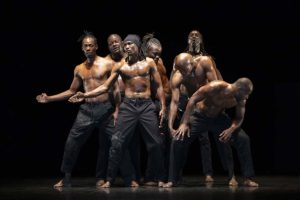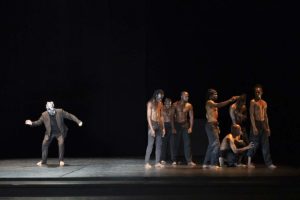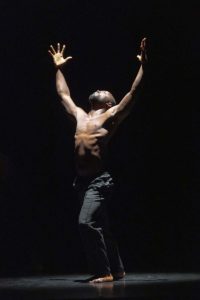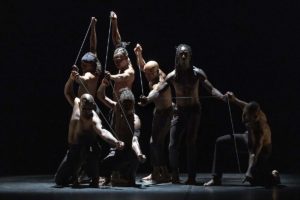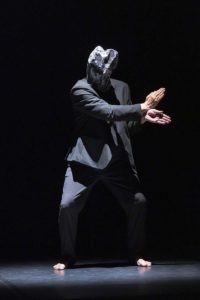Choregraphy
Josef Nadj
Interpreters
Timothé Ballo, Abdel Kader Diop, Aipeur Foundou, Bi Jean Ronsard Irié, Jean-Paul Mehansio, Sombewendin Marius Sawadogo, Boukson Séré et Josef Nadj
Artistic collaboration
Ivan Fatjo
Technical director and lights
Sylvain Blocquaux
Costums
Paula Dartigues
Musics
Fritz Hauser, Famoudou Don Moye & Tatsu Aoki, Art Ensemble Of Chicago, Malachi Favors Maghostut & Tatsu Aoki, Peter Vogel, Christian Wolfarth, Lucas Niggli
Production, Diffusion
Bureau Platô Séverine Péan et Mathilde Blatgé
Administration
Laura Petit
Executive production
Atelier 3+1
Coproductions
Montpellier Danse, Le Trident, Scène nationale de Cherbourg, MC 93 Maison de la culture de Seine-Saint-Denis, Bobigny, Charleroi Danse, Le Tropique Atrium, Fort-de-France, Théâtre des Salins, Scène nationale de Martigues, Le Théâtre d’Arles
Supports
Ministère de la Culture -DRAC Ile de France, Action financée par la Région Île-de-France, Teatroskop – un programme initié par l’Institut français, le ministère de la Culture et le ministère de l’Europe et des Affaires étrangères
Residences
With the support of Montpellier Danse 2024, creative residency at l’Agora, cité internationale de la danse, with support from Fondation BNP Paribas, CND – Centre National de la Danse à Pantin, Paris, Charleroi Danse, La Cocoteraie des arts, Mondoukou, Artus Studio, Budapest, Le Trident, Scène nationale de Cherbourg, MC 93 Maison de la culture de Seine-Saint-Denis, Bobigny (put in order, starting with the last)
With the support of la Maison des Métallos.
Full Moon follows Josef Nadj’s previous creation, Omma (2020), which was the fruit of research into the origins of dance, the origins of movement, carried out with eight dancers from Africa. Seven of them wanted to continue the adventure, and the choreographer once again encouraged them to delve deep within themselves, into their buried memories, to confront the rhythms and energies that constitute them – the rhythms and energies of the earth, of nature, as well as those of their respective cultures and traditions, thus affirming, within the group, the expression of their personal identity, the particularities of each.
In addition to this research into sources, Nadj also wished to explore another “track” for this creation: the world of black American jazz, from its original forms to the present day – a genre that has been appropriated by whites, and whose dance component has almost completely disappeared. He focused on the period from the late 1950s to the early 1980s, a period that particularly appeals to him. Contemporary with the African-American emancipation movement, this period saw a kind of intellectual and musical revolution take place in Chicago and New York, giving rise to free jazz and improvised music. Together with the dancers, Josef Nadj set about analyzing the forms specific to this music, extracting its spirit and thought, and searching for a dance that corresponded to it. Born of this “fascinating work”, Full Moon pays implicit tribute to some of the most eminent representatives of this movement: Charles Mingus, Cecil Taylor, Anthony Braxton and the Art Ensemble of Chicago.
Yet another figure is called upon in Full Moon, that of the puppet, which, like the mask, runs through all Josef Nadj’s work. Like the mask, the puppet runs through all of Josef Nadj’s work. The reason this figure, like the mask, recurs here is that both are very present in African cultures, but not only. Envisaged as the point of junction, the tipping point between the inert and the living, the animate and the inanimate, it carries another meaning than the “living” body, to which it provides a kind of counterpoint. But for Nadj, this figure also conveys the principle of life imprisoned in form. In this sense, the presence of the puppet, of the “puppet man” alongside the living, represents for him the fact that a creation is never perfect, and that it imposes the need to accept the game, even in its imperfection.
Myriam Blœdé
23.05.2024 2024
FESZT FESTIVAL
TIMISOARA (RO)
17.06.2024
FLOW FESTIVAL
SFANTU GHEORGHE (RO)
24,25 & 26.06.2024
MONTPELLIER DANSE
MONTPELLIER (FR)
12.07.2024
FESTIVAL DE ALMADA
ALMADA (PO)
18.07.2024
KALAMATA DANCE FESITVAL
KALAMATA
19.07.2024
KALAMATA DANCE FESITVAL
KALAMATA
23.07.2024
MITTELFEST
CIVIDALE DEL FRUILI (IT)
27.09.2024
THÉÂTRE D’ARLES
ARLES (FR)
03.10.2024
LE TRIDENT
SCÈNE NATIONALE DE CHERBOURG EN CORENTIN (FR)
04.10.2024
LE TRIDENT
SCÈNE NATIONALE DE CHERBOURG EN CORENTIN (FR)
12.10.2024
MESS FESTIVAL
SARAJEVO (BO)
17,18,19.10.2024
MC93
BOBIGNY (FR)
05.11.2024
THÉÂTRE DES SALINS
SCÈNE NATIONALE DE MARTIGUES (FR)
14.11.2024
LE NOUVEAU RELAX
CHAUMONT (FR)
19.11.2024
DESIRE CENTRAL FESTIVAL
SUBOTICA (SE)
20.11.2024
DESIRE CENTRAL FESTIVAL
SUBOTICA (SE)
25.11.2024
JOURNÉES THÉATRALES DE CARTHAGE
TUNIS (TU)
01.03.2025
SCENARIO PUBBLICO
CATANIA (SI)
02.03.2025
SCENARIO PUBBLICO
CATANIA (SI)
03.04.2025
LES THÉÂTRES DE LA VILLE DE LUXEMBOURG
LUXEMBOURG
04.04.2025
LES THÉÂTRES DE LA VILLE DE LUXEMBOURG
LUXEMBOURG
30.04.2025
THÉATRE ROMAIN ROLLAND
VILLEJUIF (FR)
16.05.2025
CHARLEROI DANSE
BELGIQUE (BE)
08.06.2025
NICOSIA MUNICIPAL THEATRE
NICOSIA (CY)
11.06.2025
RIALTO THEATRE
LIMASSOL (CY)
28.09.2025
GDANSK DANCE FESTIVAL
GDANSK (PO)
31.10.2025
CENTRE CULTURE FRANCO GUINEEN
CONAKRY (GU)
07.11.2025
INSTITUT FRANCAIS DE COTE D’IVOIRE
ABIDJAN (CI)
09.11.2025
COCOTERAIE DES ARTS
MONDOUKOU (CI)
14.11.2025
INSTITUT FRANCAIS DU BÉNIN
COTONOU (BE)
19.11.2025
INSITUT FRANCAIS DU TOGO
LOMÉ(TO)
22.11.2025
INSTITUT FRANCAIS DU SÉNÉGAL
DAKAR (SE)
04.11.2025
DE WARANDE
THURNOUT (BE)
23.01.2026
L’OCTOGONE, THÉATRE DE PULLY
PULLY (SU)
27.01.2026
LE GRAND ANGLE
VOIRON (FR)
28.04.2026
L’ESPACE DES ARTS
CHALON SUR SAONE (FR)
16.05.2026
TEATRO DI NAPOLI, TEATRO MERCADANTE
NAPOLI (IT)
